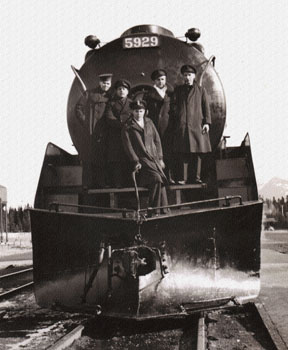Article
Koje-Do
Koje-Do (now Geojedo), is an island 40 kilometers southwest of Busan, South Korea, where the United States operated a prisoner of war (POW) camp during the Korean War. North Korean and Chinese prisoners rebelled and seized the camp.

Enter your search term
Signing up enhances your TCE experience with the ability to save items to your personal reading list, and access the interactive map.
Create AccountArticle
Koje-Do (now Geojedo), is an island 40 kilometers southwest of Busan, South Korea, where the United States operated a prisoner of war (POW) camp during the Korean War. North Korean and Chinese prisoners rebelled and seized the camp.
"https://development.thecanadianencyclopedia.ca/images/tce_placeholder.jpg?v=e9dca980c9bdb3aa11e832e7ea94f5d9" // resources/views/front/categories/view.blade.phphttps://development.thecanadianencyclopedia.ca/images/tce_placeholder.jpg?v=e9dca980c9bdb3aa11e832e7ea94f5d9

Article
The Korean War began 25 June 1950, when North Korean armed forces invaded South Korea. The war’s combat phase lasted until an armistice was signed 27 July 1953. Canadian military personnel were part of a United Nations (UN) force consisting of 16 countries; 26,791 Canadians served during the combat phase and nearly 7,000 served as peacekeepers from 1953 to 1957. The last Canadian military personnel left Korea in 1957. After the two world wars, Korea remains Canada’s third-bloodiest overseas conflict, taking the lives of 516 Canadians and wounding more than 1,000. In total, an estimated three million people died during the war. More than half were civilians. The two Koreas remain technically at war today.
"https://d2ttikhf7xbzbs.cloudfront.net/media/media/51271c17-62c2-4218-a3d3-55323d04a04e.jpg" // resources/views/front/categories/view.blade.phphttps://d2ttikhf7xbzbs.cloudfront.net/media/media/51271c17-62c2-4218-a3d3-55323d04a04e.jpg

Article
“Within sight of this house over 100 men of the Queen’s Own Rifles were killed or wounded, in the first few minutes of the landings.”
"https://d2ttikhf7xbzbs.cloudfront.net/media/media/3a69be0a-4b74-40aa-a2d9-cfe6007d77a2.jpg" // resources/views/front/categories/view.blade.phphttps://d2ttikhf7xbzbs.cloudfront.net/media/media/3a69be0a-4b74-40aa-a2d9-cfe6007d77a2.jpg

Article
During the SOUTH AFRICAN WAR 90 officers and men of the Royal Canadian Dragoons were assigned to cover the retreat of a British infantry column under attack by several hundred Boer horsemen near Leliefontein farm, east Transvaal.
"https://development.thecanadianencyclopedia.ca/images/tce_placeholder.jpg?v=e9dca980c9bdb3aa11e832e7ea94f5d9" // resources/views/front/categories/view.blade.phphttps://development.thecanadianencyclopedia.ca/images/tce_placeholder.jpg?v=e9dca980c9bdb3aa11e832e7ea94f5d9

Article
The Mackenzie-Papineau Battalion was a battalion of Canadians that fought against fascist forces in the Spanish Civil War (1936–39). It is also a collective name for more than 1,500 Canadian volunteers who served in the conflict, either with the “Mac-Paps” or in other units.
"https://d2ttikhf7xbzbs.cloudfront.net/Mac-Pap/Soldiers_Mac-Paps.jpg" // resources/views/front/categories/view.blade.phphttps://d2ttikhf7xbzbs.cloudfront.net/Mac-Pap/Soldiers_Mac-Paps.jpg

Article
Meet the Navy. Royal Canadian Navy musical revue produced during World War II under the supervision of Capt Joseph P. Connolly, director of Special Services for the RCN. Rehearsals began in June 1943 at Hart House in Toronto.
"https://d2ttikhf7xbzbs.cloudfront.net/media/media/1b768fed-d683-4f4c-a8d2-b07fa59c1b04.jpg" // resources/views/front/categories/view.blade.phphttps://d2ttikhf7xbzbs.cloudfront.net/media/media/1b768fed-d683-4f4c-a8d2-b07fa59c1b04.jpg

Article
A merchant navy (or merchant marine) is a fleet of commercial vessels that carries troops and supplies in wartime. The history of Canada’s merchant fleet is one of up and downs. From the heady days of the late 19th century to its virtual disappearance a few years later, through a rapid build-up as a key Allied component during the Second World War, to its final demise in mid-20th century, Canada’s Merchant Navy has not been treated well.
"https://d2ttikhf7xbzbs.cloudfront.net/media/media/bcd949e2-4a12-436b-9ba1-70a4f01b0db8.jpg" // resources/views/front/categories/view.blade.phphttps://d2ttikhf7xbzbs.cloudfront.net/media/media/bcd949e2-4a12-436b-9ba1-70a4f01b0db8.jpg

Article
The Military Service Act became law on 29 August 1917. It was a politically explosive and controversial law that bitterly divided the country along French-English lines. It made all male citizens aged 20 to 45 subject to conscription for military service, through the end of the First World War. As such, the Act had significant political consequences. It led to the creation of Prime Minister Borden’s Union Government and drove most of his French-Canadian supporters into opposition.
"https://d2ttikhf7xbzbs.cloudfront.net/media/media/1a7b61ee-ed48-4f36-bedd-c816ea64a819.jpg" // resources/views/front/categories/view.blade.phphttps://d2ttikhf7xbzbs.cloudfront.net/media/media/1a7b61ee-ed48-4f36-bedd-c816ea64a819.jpg

Article
The Ministry of Overseas Military Forces was established in November 1916 to administer Canadian forces in the UK, especially in the training of reinforcements, and to act as the communications channel between the Militia Department, the British War Office, and the Canadian Corps in France.
"https://development.thecanadianencyclopedia.ca/images/tce_placeholder.jpg?v=e9dca980c9bdb3aa11e832e7ea94f5d9" // resources/views/front/categories/view.blade.phphttps://development.thecanadianencyclopedia.ca/images/tce_placeholder.jpg?v=e9dca980c9bdb3aa11e832e7ea94f5d9

Article
Mount Sorrel was the objective of an important battle between Canadian and German soldiers in the First World War.
"https://development.thecanadianencyclopedia.ca/images/tce_placeholder.jpg?v=e9dca980c9bdb3aa11e832e7ea94f5d9" // resources/views/front/categories/view.blade.phphttps://development.thecanadianencyclopedia.ca/images/tce_placeholder.jpg?v=e9dca980c9bdb3aa11e832e7ea94f5d9

Article
Since the end of the First World War, monuments commemorating the lives of Canadians who died in conflicts overseas have occupied a prominent place in our urban cultural landscape.
"https://d2ttikhf7xbzbs.cloudfront.net/media/media/162485bf-95f4-4d5c-a699-2dec659d831e.jpg" // resources/views/front/categories/view.blade.phphttps://d2ttikhf7xbzbs.cloudfront.net/media/media/162485bf-95f4-4d5c-a699-2dec659d831e.jpg

Memory Project Archive
During the Second World War, Sheila Elizabeth Whitton was a coder for the Canadian Navy. Whitton was sent to England in preparation for D-Day to work on coding machines instrumental to the Allies’ success. Read and listen to Whitton’s recount of the loss of her husband in the war and the resilience she had to put forward. Please be advised that Memory Project primary sources may deal with personal testimony that reflect the speaker’s recollections and interpretations of events. Individual testimony does not necessarily reflect the views of the Memory Project and Historica Canada.
"https://d2ttikhf7xbzbs.cloudfront.net/MemoryProject/Whitton_Coder_Tweet.jpg" // resources/views/front/categories/view.blade.phphttps://d2ttikhf7xbzbs.cloudfront.net/MemoryProject/Whitton_Coder_Tweet.jpg

Memory Project Archive
Tad Szablewski was a member of the Polish Air Force during the Second World War.Please be advised that Memory Project primary sources may deal with personal testimony that reflect the speaker’s recollections and interpretations of events. Individual testimony does not necessarily reflect the views of the Memory Project and Historica Canada.Content warning: This article contains content which some may find offensive or disturbing.
"https://d2ttikhf7xbzbs.cloudfront.net/The-Memory-Project/image/7036_original.jpg" // resources/views/front/categories/view.blade.phphttps://d2ttikhf7xbzbs.cloudfront.net/The-Memory-Project/image/7036_original.jpg

Article
Mutual Aid is the principal economic means by which Canada assisted its allies with food, raw materials and munitions from May 1943 until the end of WORLD WAR II. The Mutual Aid Board, chaired by C.D.
"https://d2ttikhf7xbzbs.cloudfront.net/media/media/5b52b570-6e9b-476a-94a9-af4ca135ac51.jpg" // resources/views/front/categories/view.blade.phphttps://d2ttikhf7xbzbs.cloudfront.net/media/media/5b52b570-6e9b-476a-94a9-af4ca135ac51.jpg

Macleans
It was June 12, 1944, and the D-Day invasion of Normandy was less than a week old. Waves of Allied bombers were pounding German positions, but on this afternoon Flying Officer Patrick Brophy, 22, from Port Arthur, Ont., was feeling uneasy.This article was originally published in Maclean's Magazine on June 10, 2002
"https://development.thecanadianencyclopedia.ca/images/tce_placeholder.jpg?v=e9dca980c9bdb3aa11e832e7ea94f5d9" // resources/views/front/categories/view.blade.phphttps://development.thecanadianencyclopedia.ca/images/tce_placeholder.jpg?v=e9dca980c9bdb3aa11e832e7ea94f5d9
